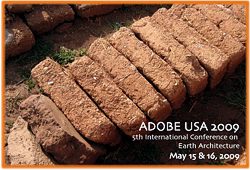Using local products for building materials are very innovative. And by using dirt from the site itself really personalizes those projects that choose to do so. Proving that the material is as durable than modern methods is the next big step.
Blog Post
The most overlooked building material in the U.S.?

The 5th Adobe Conference of the Adobe Association of the Southwest, AdobeUSA 2009, will take place May 15 and 16, 2009 in El Rito, New Mexico on the campus of co-sponsor Northern New Mexico College in Cutting Hall Auditorium. Engineering and Architect Professionals will be eligible to obtain Continuing Education Units (PDH) during the conference.Check out the abstracts, including great-sounding titles like:
· Adobe 2030 · ASTM earthen building standards · Mechanical performance of nonindustrial building materials manufactured with clay as a natural binder · The Effect Interior Earthen plasters and Exterior Lime plasters have on Controlling Temperature and Humidity in Building EnvelopeWhat other natural materials can we use?
Published May 7, 2009 Permalink Citation
(2009, May 7). The most overlooked building material in the U.S.?. Retrieved from https://www.buildinggreen.com/blog/most-overlooked-building-material-us



Add new comment
To post a comment, you need to register for a BuildingGreen Basic membership (free) or login to your existing profile.